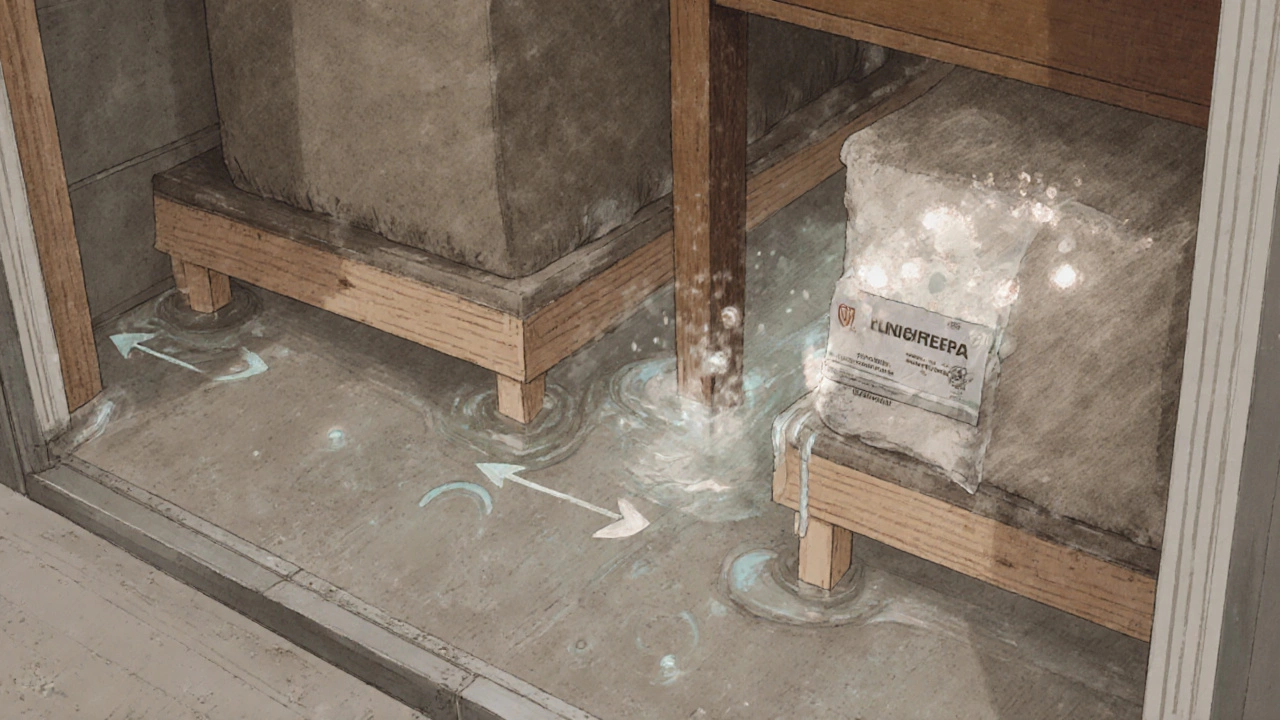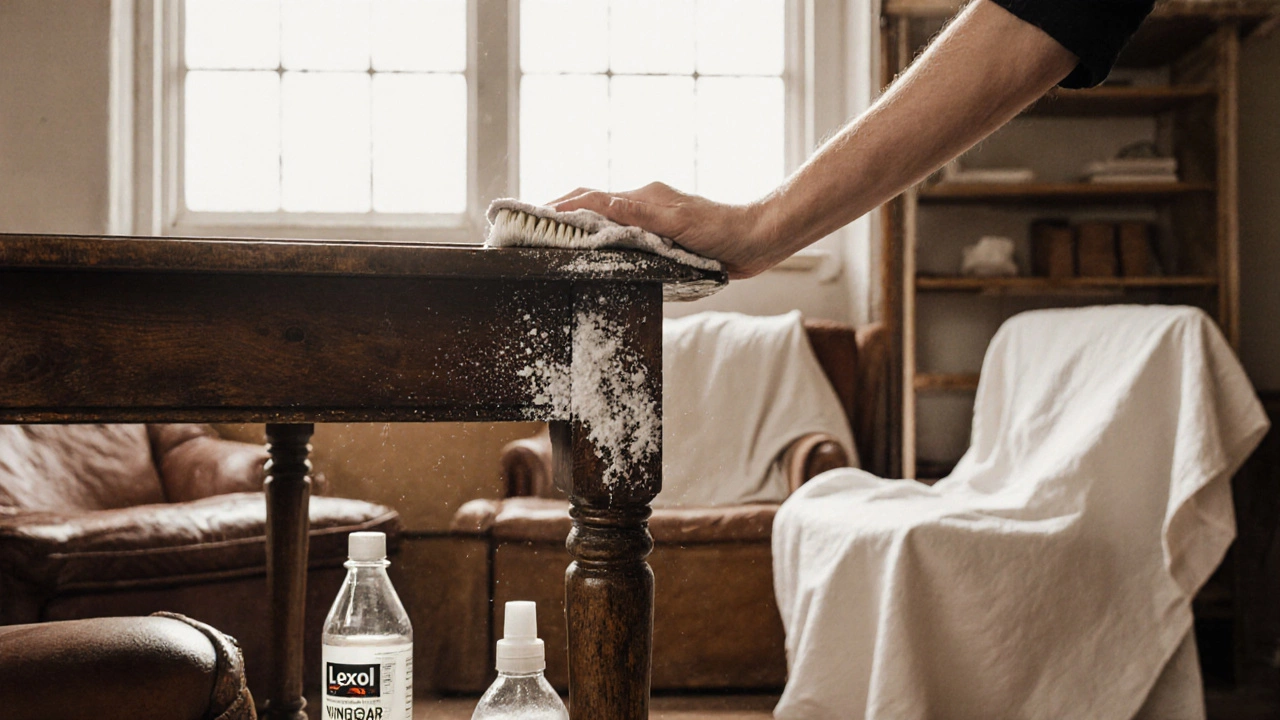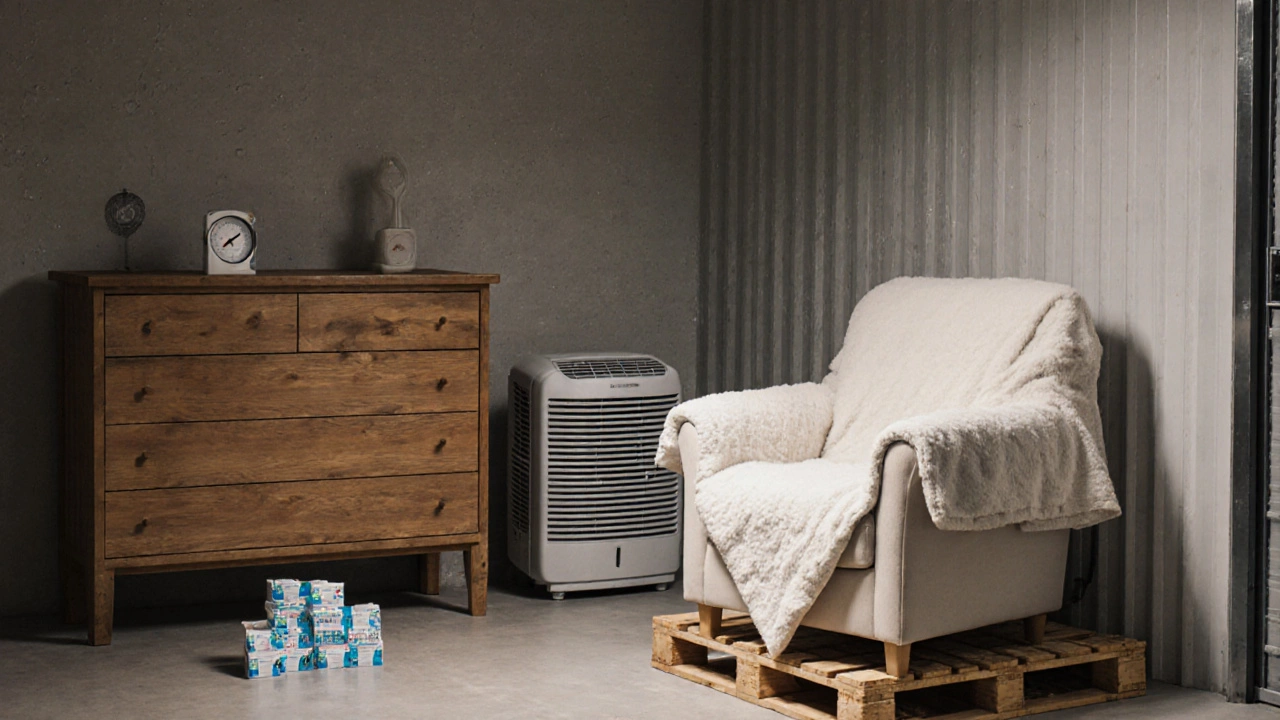Humidity Control Calculator
Calculate Your Humidity Control Needs
Enter your storage unit dimensions and humidity levels to determine the right amount of desiccant packs and moisture control needed to protect your furniture.
Storage Unit Dimensions
Humidity Settings
Recommended Control Measures
If you’ve ever opened a storage unit to find your wooden chair warped, your dresser covered in mildew, or your leather sofa smelling like a basement, you know how quickly damp can ruin furniture. It’s not just about looks-it’s about money. A single high-quality sofa can cost over £1,000. Damp doesn’t just stain; it eats away at glue, warps wood, and rusts metal frames. And once it starts, it doesn’t stop until you fix the root cause.
Why Damp Destroys Furniture in Storage
Damp isn’t just water on the surface. It’s moisture in the air that gets absorbed by porous materials like wood, fabric, and leather. In storage units-especially concrete ones in places like Birmingham-temperature swings cause condensation. At night, the air cools and holds less moisture. That extra water turns into droplets on your furniture. Over weeks, this adds up.
Wood swells when wet, then cracks when it dries out unevenly. Upholstery traps moisture, turning into a breeding ground for mold. Metal legs rust. Even high-end pieces from IKEA or Drew Barrymore’s line can fall apart if left unprotected. The problem isn’t just rain or leaks. It’s humidity. Even in a dry-looking unit, relative humidity above 60% is dangerous for furniture.
Step-by-Step: How to Prepare Furniture for Storage
Protecting your furniture starts before you even move it into storage. Here’s what actually works:
- Deep clean everything. Dust, dirt, and spills attract moisture. Wipe down wood with a microfiber cloth and a mix of water and white vinegar. Vacuum fabric and leather with a brush attachment. Don’t forget the undersides.
- Disassemble where possible. Take apart bed frames, tables, and shelves. Store legs and screws in labeled ziplock bags taped to the main piece. This reduces stress on joints and lets air circulate better.
- Let it dry completely. Never store damp furniture. Even if it looks dry, leave it in a well-ventilated room for 48 hours. Use a dehumidifier if you have one.
- Use breathable covers. Skip plastic wrap. It traps moisture like a sauna. Instead, use cotton sheets or specialized furniture moving blankets. These let air flow while blocking dust.
- Elevate off the floor. Place pallets, wooden blocks, or even heavy-duty plastic furniture risers under everything. Concrete floors sweat. Even a 2-inch gap stops capillary moisture from rising into your pieces.

Best Humidity Control Tools for Storage Units
Humidity control isn’t optional-it’s non-negotiable. Here are the only tools that deliver real results:
- Desiccant packs (silica gel): Use 10-15 large packs (500g each) per 100 sq ft of space. Place them on shelves, under furniture, and near corners. Recharge them in the oven every 2-3 months at 200°F for 2 hours.
- Electric dehumidifiers: If your storage unit has power, a small 10-pint unit like the hOmeLabs model runs quietly and drains into a bucket. Set it to 50% humidity. It’s the single most effective tool for long-term storage.
- Charcoal bags: Natural, odor-absorbing, and low-maintenance. Place them in corners and near leather items. They last 6-12 months and are safe around kids and pets.
- Moisture-absorbing crystals: Products like DampRid work well for smaller spaces. Replace them when they turn to liquid. Avoid the scented versions-they leave residue.
Don’t waste money on plug-in air fresheners, mothballs, or cedar blocks alone. They smell nice but don’t reduce humidity. You need active moisture removal.
What to Avoid in Storage
Some common advice is flat-out wrong. Here’s what not to do:
- No plastic wrap. It seals in moisture. Wood needs to breathe. Plastic turns your dresser into a greenhouse.
- No cardboard boxes. Cardboard absorbs moisture like a sponge. If you must box items, use plastic bins with tight lids-preferably clear ones so you can see inside.
- No newspapers. Ink transfers and paper holds moisture. Use acid-free tissue paper instead if you need padding.
- No storing near walls. Walls, especially concrete, get colder and damper. Keep furniture at least 6 inches away from all sides.
- No storing in basements. Even if it’s labeled "climate-controlled," most basement units are still below ground. Humidity levels are 20-30% higher than above-ground units.

Checking Your Furniture After Storage
When you retrieve your pieces, don’t just pull them out and start using them. Take 15 minutes to inspect:
- Smell it. Musty odor? That’s mold. Wipe with a cloth dampened with vinegar and water. Let it dry in sunlight if possible.
- Feel the wood. If it feels spongy or crumbly, the glue or grain is damaged. You may need professional restoration.
- Check joints. Wobble? Glue may have failed. Use wood glue and clamps to repair. Don’t just nail it back.
- Look for white powder. That’s salt bloom from moisture evaporating from wood. Brush it off gently. It’s not mold, but it means the wood was exposed.
If you find mold on fabric, don’t just spray it. Take the cushion covers off and wash them at 60°C. For leather, use a pH-balanced cleaner like Lexol. Never use bleach or alcohol.
Long-Term Storage: What to Do if You’re Storing for Over a Year
For extended storage-say, during a move overseas or a renovation that takes 18 months-do more:
- Apply a thin coat of beeswax polish to wood surfaces. It creates a barrier without sealing them.
- Use a hygrometer to monitor humidity inside the unit. Buy one for under £15. If it climbs above 60%, add more desiccant or turn on the dehumidifier.
- Visit the unit every 3 months. Open covers, air out pieces, and check for moisture buildup. A quick 10-minute check can save you £500 in repairs.
- Consider climate-controlled storage. It’s 20-30% more expensive, but for antiques, heirlooms, or expensive modern pieces, it’s worth it. Look for units with active HVAC, not just "insulated walls."
Don’t assume your furniture will be fine. One damp winter in the Midlands can ruin years of care. The difference between saving your furniture and losing it comes down to two things: airflow and moisture control. Get those right, and your pieces will last decades.
Can I use a fan to dry out my furniture in storage?
No. Fans blow air, but they don’t remove moisture. If the air is already humid, a fan just circulates damp air around your furniture. It can even push moisture deeper into wood and fabric. Use a dehumidifier instead-it pulls water out of the air. A fan only helps if you’re drying something immediately after cleaning, not during long-term storage.
Is it safe to store furniture in a garage?
Only if it’s fully sealed, insulated, and climate-controlled. Most garages are not. They get cold in winter, hot in summer, and often have damp concrete floors. If you must use a garage, elevate everything on pallets, cover with breathable fabric, and use silica gel packs. But a dedicated storage unit is far safer.
What’s the best humidity level for storing furniture?
Keep humidity between 40% and 50%. Below 40%, wood can crack from drying out too fast. Above 50%, mold and warping become risks. In the UK, especially in autumn and winter, humidity often climbs to 70% or higher indoors. That’s why active control is necessary-even in so-called "dry" storage units.
Can I store upholstered furniture on its side?
Never. Upholstered pieces like sofas and armchairs should always be stored upright. Laying them on their side puts pressure on the frame and springs, causing sagging. It also traps moisture against the fabric, increasing mold risk. If space is tight, disassemble the frame or store it vertically against a wall with space around it.
How do I know if my storage unit is climate-controlled?
Ask if it has active HVAC (heating, ventilation, and air conditioning), not just insulation or double walls. Climate-controlled units maintain a steady temperature (around 18-22°C) and humidity (40-50%) year-round. Call the facility and ask for their humidity readings during summer and winter. If they don’t know, it’s not truly climate-controlled.


Write a comment